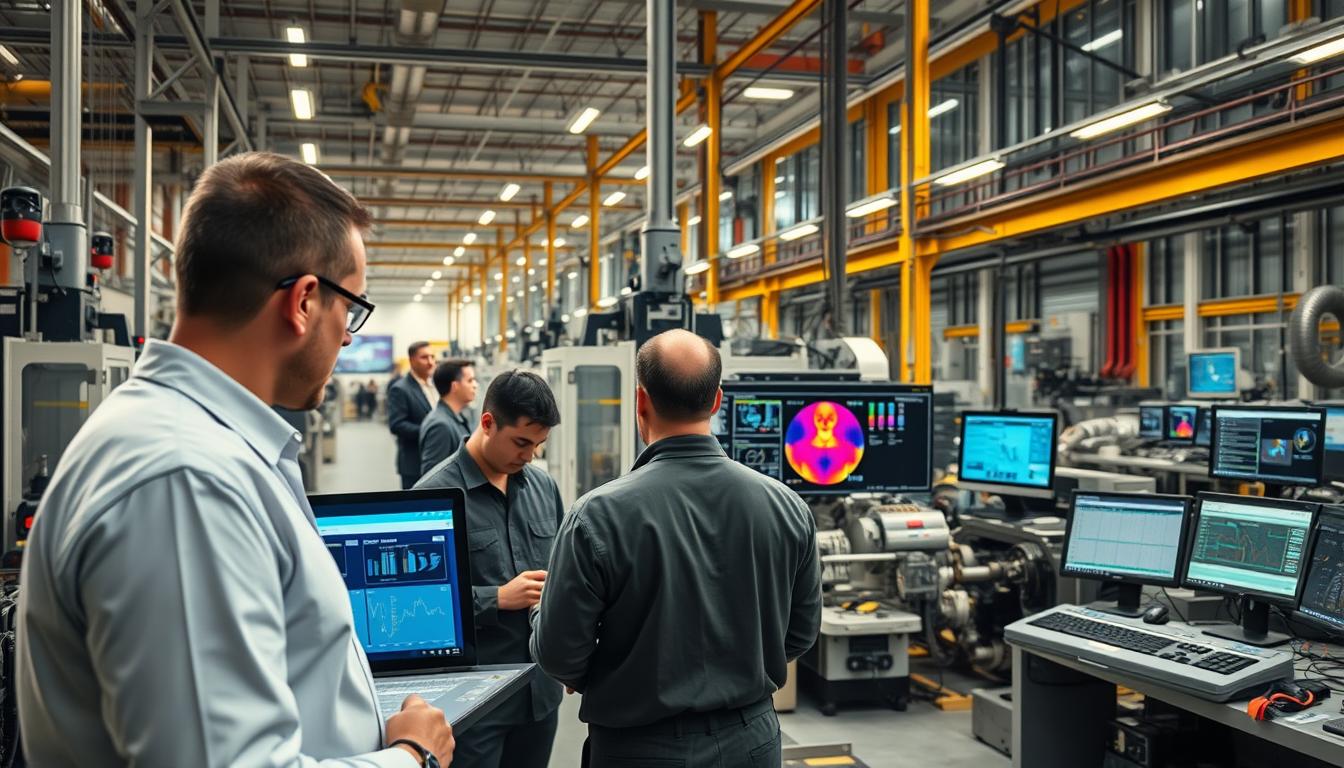Imagine a Midwest HVAC company that lost $250,000 last year when critical equipment failed during a winter storm. Their traditional maintenance schedule missed early signs of compressor wear. This story isn’t unique – unplanned downtime costs Fortune 500 companies 11% of annual revenue, according to Deloitte.
Today’s service firms face a critical choice. Should they stick with calendar-based upkeep or adopt smarter methods? One approach uses real-time insights to spot issues 3-6 months before failure. The other relies on fixed timelines, sometimes repairing parts that still work fine.
New research reveals surprising gaps. Companies using advanced analytics cut downtime by 15% and boost productivity 20%. For a mid-sized factory, that’s like gaining 12 extra production days yearly. But making the switch requires understanding both strategies’ financial impacts.

Key Takeaways
- Unplanned outages drain 11% of revenue for large corporations
- Smart monitoring can boost workforce efficiency by 20%
- IoT sensors enable 92% more accurate failure predictions
- Early problem detection slashes repair costs by 40%
- Hybrid approaches work best for mixed equipment ages
We’ll break down how modern tools – from vibration sensors to AI – are reshaping equipment care. You’ll see exactly when data-driven methods outperform traditional plans, and how to calculate potential savings for your operation.
Introduction: Breaking Down Predictive and Preventive Maintenance
Service firms across industries face a crucial decision in optimizing their machinery upkeep. Modern strategies split into two camps: one reacting to real-time insights, the other following preset calendars.
What is Predictive Maintenance?
This method acts like a fitness tracker for industrial gear. Connected devices feed live information about machine health to analytics platforms. Teams receive alerts when systems detect unusual vibration patterns or temperature spikes.
Advanced algorithms compare current readings with historical performance. This helps spot worn bearings or lubrication issues months before breakdowns occur. Repairs happen only when needed, avoiding unnecessary part replacements.
Overview of Preventive Maintenance
The traditional approach works like routine dental checkups. Technicians service assets at fixed intervals – weekly, monthly, or quarterly. Tasks include oil changes, filter replacements, and system inspections.
While effective for newer machinery, this method can waste resources on older equipment. Imagine replacing perfectly good belts just because the calendar says to. It’s reliable but not always efficient.
Both strategies have their place. Newer facilities might lean on sensor-driven insights, while mixed-age operations often blend both methods. The right choice depends on equipment age, budget, and downtime tolerance.
The Economic Impact of Maintenance Strategies for Service Firms
Unplanned equipment failures are more than just inconvenient—they’re profit killers. A single breakdown can trigger a chain reaction of lost productivity, rushed repairs, and unhappy customers. For manufacturers, these incidents chew through 5-20% of production capacity. That’s like working one month each year for free.

Reducing Downtime and Cutting Costs
Take automotive plants as an example. Major facilities now face $695 million annual losses from halted assembly lines—a figure that’s jumped 150% since 2019. But the pain doesn’t stop there. Emergency part replacements and overtime labor add 30-40% to the original repair bill.
Smart monitoring systems flip this script. By catching issues like motor wear or coolant leaks early, companies slash unplanned outages by up to 45%. One food packaging plant avoided $2.3 million in losses last year simply by replacing bearings before they failed.
The best part? These systems don’t just prevent disasters. They help teams use resources smarter. Instead of changing parts on a fixed schedule, technicians fix what’s actually broken. This approach trims upkeep expenses by 18-22% annually for most manufacturers.
Forward-thinking firms now view equipment care as a profit protector. With real-time data guiding decisions, they keep machines running longer while spending less on fixes. It’s like having a financial safety net for your most critical assets.
Core Technologies Fueling Modern Maintenance Strategies
Behind every humming factory floor lies a network of invisible guardians. These digital watchdogs work silently, using cutting-edge tools to catch equipment whispers before they become breakdown screams.
IoT Sensors and Real-Time Data Collection
Tiny sensors act as equipment translators. They track temperature spikes, unusual vibrations, and fluid changes 24/7. This constant stream of information flows to central systems, creating a live health report for every machine.
AI, Machine Learning, and Digital Twin Innovations
Smart algorithms compare current data with years of historical patterns. They spot anomalies humans might miss – like a bearing wearing 0.2% faster than normal. Virtual machine clones let teams test repair scenarios risk-free, using digital replicas that mirror real-world performance.
Analytics and Cloud-Based Solutions
Cloud platforms handle heavy data lifting. They crunch numbers from multiple locations, spotting trends across entire fleets. These systems learn continuously, improving failure predictions with each new piece of information.
When sensors detect trouble signs, automated alerts ping technicians. Teams see prioritized tasks on dashboards, complete with repair instructions. This tech combo turns guesswork into precision – like having X-ray vision for industrial equipment.
Enhancing Equipment Reliability Through Predictive Maintenance
Modern machinery speaks through subtle clues – if you know how to listen. Advanced tracking systems now decode these signals, transforming routine upkeep into precision care.

Continuous Monitoring and Early Detection
Imagine sensors acting as 24/7 translators for your gear. Temperature spikes become warning flares for blocked airflow. Unusual vibrations turn into SOS signals about loose bearings. These systems catch whispers of trouble months before breakdowns shout.
Thermal cameras spot electrical hotspots invisible to the naked eye. Vibration analysis pinpoints misalignment down to 0.001 inches. Ultrasound devices hear failing components before they make audible noises. Together, they create a digital health chart for every machine.
Fluid checks reveal secrets too. Oil analysis detects metal fragments smaller than a human hair. Contamination alerts show when lubricants need changing – not just when the calendar says. This prevents 73% of gearbox failures in heavy machinery.
These techniques form an early-warning network. One chemical plant reduced unplanned stops by 68% using combined sensor data. Their mix of thermal imaging and vibration tracking caught pump issues 14 weeks before critical failure.
Reliable operations start with understanding your equipment’s language. When teams respond to its needs proactively, uptime improves and repair bills shrink. It’s like giving your machinery a voice – and finally hearing what it’s been trying to say.
Comparative Analysis: Preventive vs Predictive Maintenance
A major cloud provider recently avoided $1.2 million in cooling system repairs by switching strategies. Their old approach replaced filters like clockwork – every 90 days. The new method waits until sensors show airflow resistance climbing past safe levels.
Cost Efficiencies and Operational Benefits
Traditional plans work like oil changes for cars – fixed intervals regardless of actual use. This often means replacing parts that still function. One study found 25% of replaced industrial belts had 50%+ life remaining.
Condition-based monitoring changes the game. Teams fix issues only when data demands action. This cuts unnecessary work by 30% while catching 92% of developing problems early. Labor hours get redirected to critical tasks instead of routine checks.
Extended machine life is another key advantage. Addressing minor bearing wear early prevents cascading failures. One automotive supplier increased press machinery lifespan by 18 months using vibration analysis.
The proof? A global manufacturer saved $4.7 million last year across 10,000 machines. Their AI system detected lubrication issues 142 days before failures occurred. ROI came faster than expected – within 90 days of implementation.
Beyond dollar savings, operational flow improves dramatically. Emergency repairs drop by 40%, letting teams plan better. Inventory costs shrink as warehouses stock only what’s truly needed. It’s like upgrading from guesswork to precision medicine for industrial gear.
Strategic Implementation in Maintenance Management
A food processing company slashed downtime by 40% after overhauling their upkeep approach. Their secret? Combining smart tech with team training. Getting this balance right separates successful programs from expensive experiments.
Making Systems Work Together
Connecting new monitoring tools with existing platforms is like teaching old dogs new tricks. Teams must bridge sensor networks with older asset tracking software. This often requires custom interfaces that speak both legacy and modern data languages.
Standardizing information formats proves crucial. Imagine trying to compare vibration data from three different machine models. Without unified measurements, alerts become noise rather than actionable insights.
Budgeting for Smart Upgrades
Initial investments often surprise firms. Installing industrial sensors costs $1,500-$4,000 per machine. Cloud analytics platforms add $10,000+ annually. But phased rollouts help manage expenses.
Training eats 25-30% of implementation budgets. Mechanics need to interpret heat maps and vibration charts instead of just wrenches. Successful firms pair classroom learning with real-world simulations.
Change management softens the transition. Weekly progress reviews and clear success metrics keep teams aligned. One manufacturer saw 90% staff adoption within six months using gamified skill badges.
The payoff comes through smarter resource use. Companies reducing emergency repairs by 50% often recoup tech costs within 18 months. It’s like planting money trees in your machine shop.
Data-Driven Decision Making with Sensor Insights
What if your machines could text you when they need help? Modern sensor networks make this possible, turning equipment into chatty partners that share vital health updates. These digital messengers collect over 200 data points per second, creating a constant conversation between assets and maintenance teams.
Smart Monitoring Through Connected Devices
Temperature trackers act like fever thermometers for machinery. They spot overheating motors weeks before smoke appears. One bottling plant avoided a conveyor meltdown by catching a 15°F spike in bearing temperatures.
Vibration sensors tell stories through movement patterns. Unusual wobbles reveal loose bolts or worn gears. A paper mill reduced unplanned stops by 33% after fixing alignment issues flagged by these detectors.
Humidity monitors explain why some components age faster. They track moisture levels that cause corrosion in electrical panels. Data shows coastal facilities face 2x faster degradation than inland plants.
Analytics platforms turn numbers into action plans. Machine learning spots tiny changes humans miss – like a pump drawing 0.3% more power. These clues help schedule fixes during planned downtime instead of crisis mode.
As systems collect more information, predictions sharpen. Early adopters see 90-day forecasts become 85% accurate within a year. It’s like watching a blurry photo come into focus – clearer insights mean smarter choices.
Teams using these tools report 22% fewer emergency calls and 18% longer equipment life. The secret? Listening to what the data whispers before it starts screaming.
Predictive Maintenance and Its Role in Maintenance Cost Reduction
Leading manufacturers are rewriting the rules of equipment care. By listening to machines through data streams, they’re preventing costly breakdowns while squeezing more value from every repair dollar.
Precision Through Analytics
GE Aviation’s jet engines now send real-time health updates from 35,000 feet. Embedded sensors track 200+ parameters, flagging issues before they ground flights. This approach cuts airline operational costs by 18% per engine cycle.
Automakers are seeing similar wins. AI systems scan welding robots 10x faster than human inspectors. One plant reduced check times by 70% while boosting weld quality. Technicians now focus on complex tasks instead of routine scans.
Proactive Problem Solving
A global delivery giant avoids sorting facility chaos using smart alerts. Their system monitors 30+ machine types, predicting failures 60 days out. Last year alone, this saved $4.2 million in emergency repairs and lost productivity.
These success stories share a common thread: actionable insights. By converting raw numbers into repair schedules, companies achieve 95% uptime rates. The result? Happier customers and healthier profit margins.
As tools evolve, so do savings. Early adopters report 22% lower annual upkeep costs and 31% fewer overtime emergencies. It’s not magic – just machines finally getting their checkups when they actually need them.
See how FieldAx can transform your Field Operations.
Try it today! Book Demo
You are one click away from your customized FieldAx Demo!
FAQ
How does predictive maintenance reduce equipment failures?
By using tools like IoT sensors and analytics, it detects early signs of wear or performance issues. This allows teams to address problems before they escalate, minimizing unexpected breakdowns and extending asset lifespans.
What role do cloud-based solutions play in modern maintenance strategies?
Cloud platforms centralize sensor data, enabling real-time monitoring and remote diagnostics. Companies like Siemens use these systems to analyze trends, optimize workflows, and share insights across teams for faster decision-making.
Can preventive methods compete with predictive approaches in cost savings?
While scheduled upkeep prevents some failures, it often leads to unnecessary part replacements. Predictive models, like those used by GE Aviation, cut costs by 12–18% through targeted repairs and reduced downtime compared to calendar-based routines.
How does vibration monitoring improve reliability?
Sensors track abnormal patterns in machinery, signaling misalignment or bearing wear. For example, Schneider Electric uses this data to prioritize repairs, preventing energy waste and avoiding catastrophic failures in motors or turbines.
What workforce skills are needed for predictive systems?
Teams need training in data interpretation and tools like IBM’s Maximo. Familiarity with AI-driven alerts and digital twin simulations helps technicians act swiftly on condition-based insights rather than fixed schedules.
Are there industries where predictive models outperform preventive ones?
Yes—manufacturing, energy, and aviation benefit most. Rolls-Royce’s engine health monitoring, for instance, boosts uptime by 25% through real-time analytics, unlike rigid preventive plans that can’t adapt to actual equipment conditions.
How do temperature sensors contribute to early fault detection?
They identify overheating in components like bearings or electrical systems. Honeywell uses thermal data to trigger maintenance alerts, preventing energy losses and reducing fire risks in industrial settings.
What’s the ROI timeline for implementing predictive tools?
Most firms see returns within 8–14 months. Reduced downtime, lower energy use, and optimized part replacements—as seen in Caterpillar’s deployments—offset initial investments in sensors and analytics platforms.
Author Bio
Co-Founder & CMO at Merfantz Technologies Pvt Ltd | Marketing Manager for FieldAx Field Service Software | Salesforce All-Star Ranger and Community Contributor | Salesforce Content Creation for Knowledge Sharing






